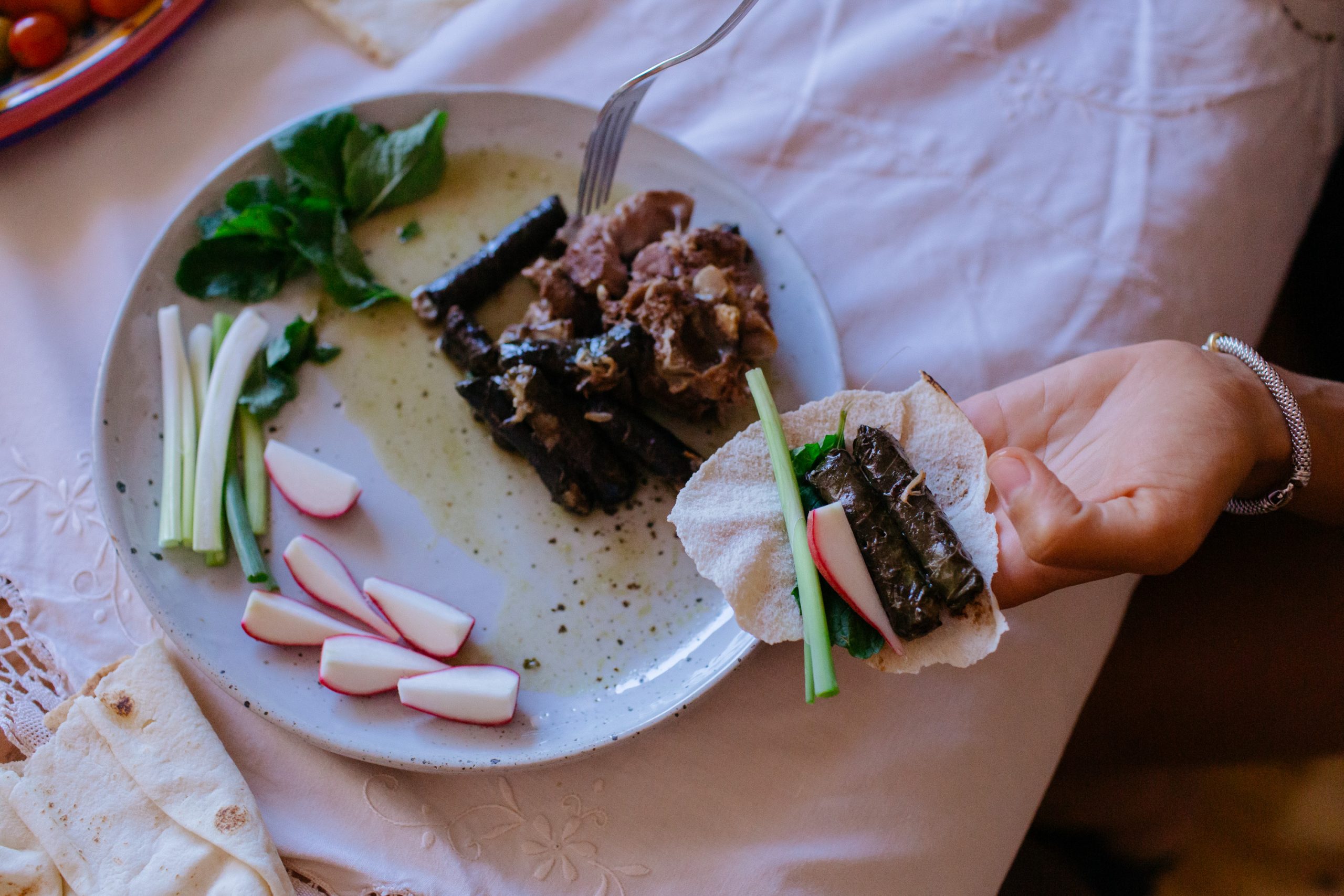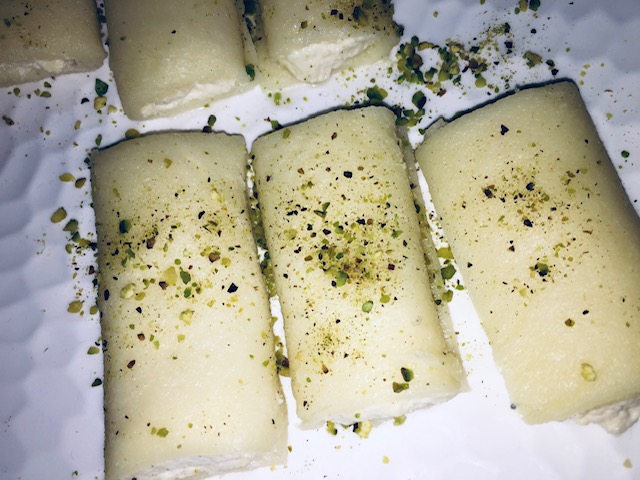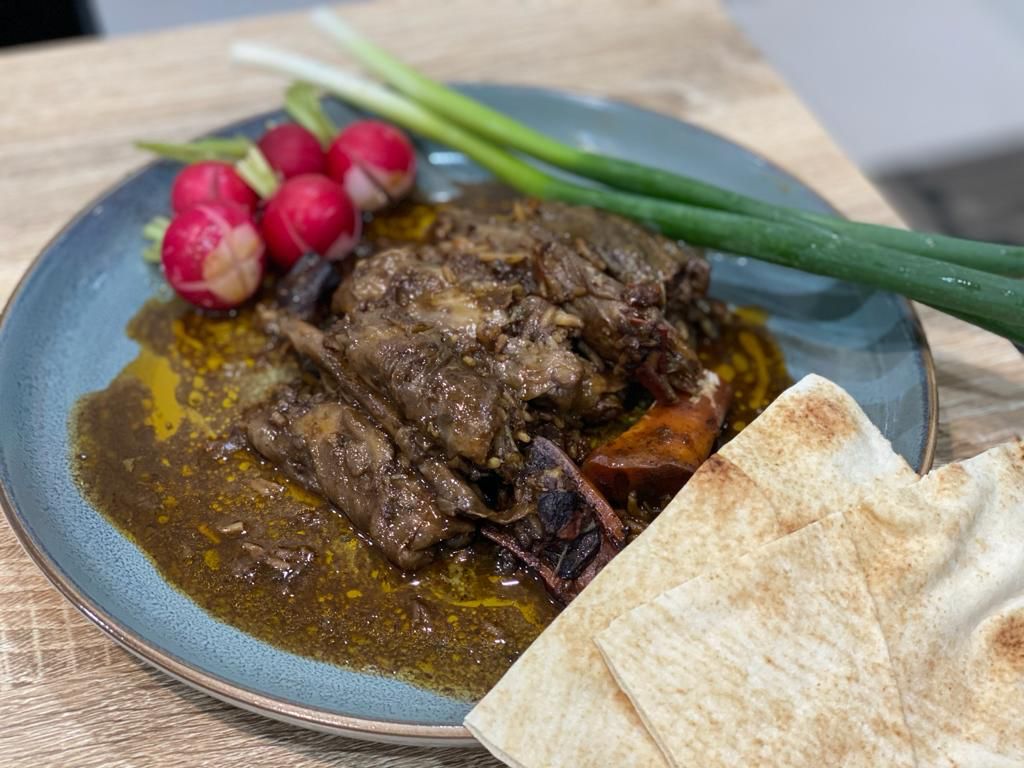Karima’s Traditional Lebanese Warak Enab
 Lebanon
Lebanon 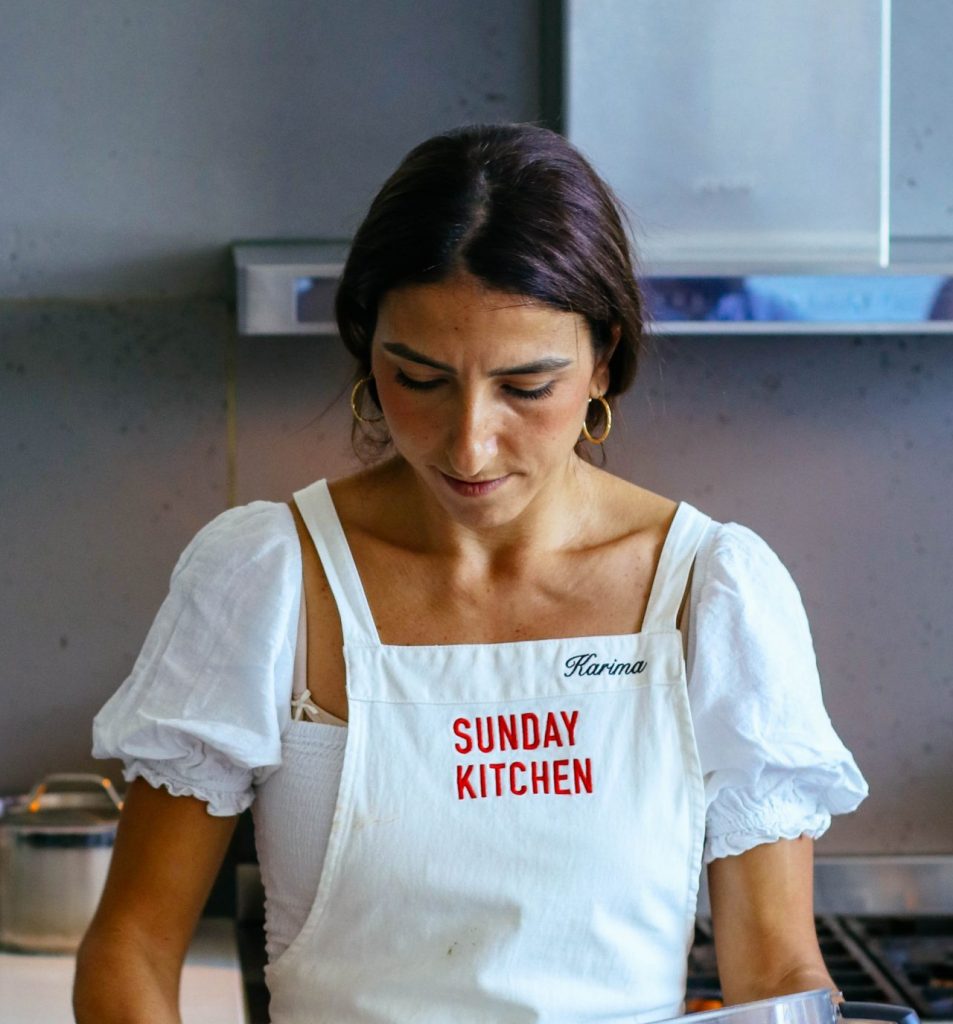
Warak Enab is to Eid what turkey is to Christmas. At least for the majority of Muslims from Lebanon and the surrounding Levant, it is this dish of lamb and stuffed vine leaves that traditionally graces the Eid table at the end of Ramadan.
After a month of fasting, the three-day festival of Eid al-Fitr literally means the festival of the breaking of the fast and Warak Enab is usually made in such large quantities that, just like turkey, it is served and enjoyed for several days. This year, today (Saturday May 15) is the third day of Eid and families across Australia as across the Middle East, will be enjoying the leftovers.
Last year with the first Covid lock-downs, it wasn’t possible to host or visit extended family and friends, and many of us found ourselves quite at a loss as to how to cater for small numbers. When I cook, I tend to cook for my little family of four plus my two sisters and my mum and my mother-in-law, portioning out into Tupperware boxes and dropping meals round. It was quite a challenge thinking small but when it came to Eid, I made vine leaves enough for 12 and ran my own covid-safe delivery service! We are so thrilled that this year we can all be together – at least to a maximum of 20 people.
When I see, touch, smell and taste Warak Enab being cooked, I am immediately transported to my Tayta’s house in Lakemba, a few days before Eid, sitting on the floor, rolling vine leaves.
My grandmother, Tayta Amineh had 15 children, my mother Sivine being number 14. Growing up terribly poor in Tripoli, a historic port city in the north of Lebanon, Tayta Amineh became resourceful at an incredibly young age. Before the war broke out, she helped establish my grandfather’s mahal helou, a sweet shop which grew into a bit of an empire, by selling cheap homemade toffee sweets to the poorer areas of the city, riding on a donkey, her dowry.
With the success of the sweet shops, the family became working middle class and Tayta Amineh relied on her “village around her” as support for raising her own large family. Meals were something she ‘declared’ to her neighbours, especially when it came to Warak Enab which was made for a variety of special occasions from Eid to weddings or the birth of a child. She would source all the ingredients – the meat, leaves, rice and spices – and would set a date to bring her community of women together to roll these tiny delicate parcels, a characteristic of Warak Enab from Tripoli. Together they made enough meals for everyone’s family to enjoy, and they shared. They shared stories of their life, their everyday struggles of family, marriage and home life and this communal act of rolling and preparing a meal for their families became a source of therapy to my Tayta Amineh and her community.
My mother was 11 when her parents moved to Australia. When she left school, she became a social worker. She worked in family support and I recall her asking my Tayta (her mother) about mental illnesses she might have experienced growing up and raising such a large family. My grandmother’s answer was simple: “We had a community, a village, not like we have here – we would cook together and talk and share. That was our therapy. We had each other’s back, as sisters, as neighbours, as women. We had the funny woman that had a joke for every struggle. We had a resourceful woman who would problem solve. We had the herbalist with a remedy for everything. We looked after each other.”
Stuffed Vine Leaves are a communal exercise and a labour of love. When Tayta cooked Warak Enab, it would even take 3 women to tip over the deep pot to serve it up! Everyone would then eat from the deep tray of vine leaves, lamb, bone and marrow. I am forever grateful for those memories.
Nowadays, every Ramadan it’s Mum who declares when we will be rolling vine leaves, just as my Tayta used to. Year after year, as we sit down and roll these precious tiny parcels, it is these stories I look forward to the most. I can still smell the aromas coming from the large pots at my Tayta Amineh’s house, blanching the vine leaves in boiling water whilst we all sat on the floor to roll. As a large family, there were often communication barriers. So many emotions lost in translation, migration and settlement in Australia. But connection was always found when cooking, especially dishes like Warak Enab. The preparation itself a therapy that my Tayta relied on to connect her back to her homeland and to communicate with us. Mum reminds me all the time “Tayta’s love language was food”. These days, with two young ones of my own, I really miss my Tayta. I have so many questions about life I wish I could have asked her. Fortunately, when I take the time to sit and prepare Warak Enab or make her favourite dishes like kousa (stuffed zucchini), I find some of the answers I am looking for.
Warak Enab asks you to slow down, it begs for your attention, care and precision when rolling, it invites you to share with those rolling with you and you are left with a sense of accomplishment, relief, and of course the indulgence of a delicious meal.
I would be distraught if my children grow up not knowing how to make this; not having some understanding of how the vines are grown and tended through to how to roll those precious little parcels. It’s an important part of my inheritance and I want it to be part of theirs.
First and foremost, you need to locate fresh leaves – worthy of the hours of rolling you are about to endure. Traditionally, such leaves came from a relative with a vine growing in their backyard but in Australia, you can generally buy them from any Lebanese grocery store. Then it is about the roll – hours of stories, laughs, debates and distractions. Whether in a group for efficiency, or just with my mum, Fairuz playing in the background.
The recipe and method I’ve shared below is the traditional one and the way it’s been done for generations, most likely for centuries. In a way it’s a guide rather than an exact recipe and as with all cooking, particularly traditional Lebanese cooking, tasting and smelling along the way is extremely important, as well as knowing what to look out for which is inevitably improved with practice.
Depending where you come from, people will say that there are many ways to roll, stuff and cook vine leaves. Our method is how the people of Tripoli in Lebanon prepare them, by rolling them into short, pinkie-sized fingers, packing them tightly in a tall Bessemer pot over a bed of lamb and bone cuts.
Today, you can buy pre-made rolls – they’re available in most Lebanese grocers and halal butchers – but you are robbing yourself of the experience. You can use a pressure cooker but you’re still short-changing yourself and your diners of the cooking aromas and the full flavour you only get from slow cooking.
Vine leaves are certainly not a dinner for two, or four. It’s a dish that brings people together from start to finish. Back in Lebanon, calling around for the leaves usually meant inviting the supplier to the meal, then a few more people to roll, and before you know it there would be twenty or more family members eating from this one pot. That has to be something really special.
Try it with friends or your extended family – or with your colleagues. It could be a great team building exercise for everyone who has lost out on working as a team over the last year…
Meanwhile Eid Mubarak to all. (Wishing you a Blessed Eid).
Karima Hazim
May 2021
Instagram @karimachloehazim and @sundaykitchenau
Photographs courtesy of Lucy Leonardi of Who Does the Dishes
Share this story
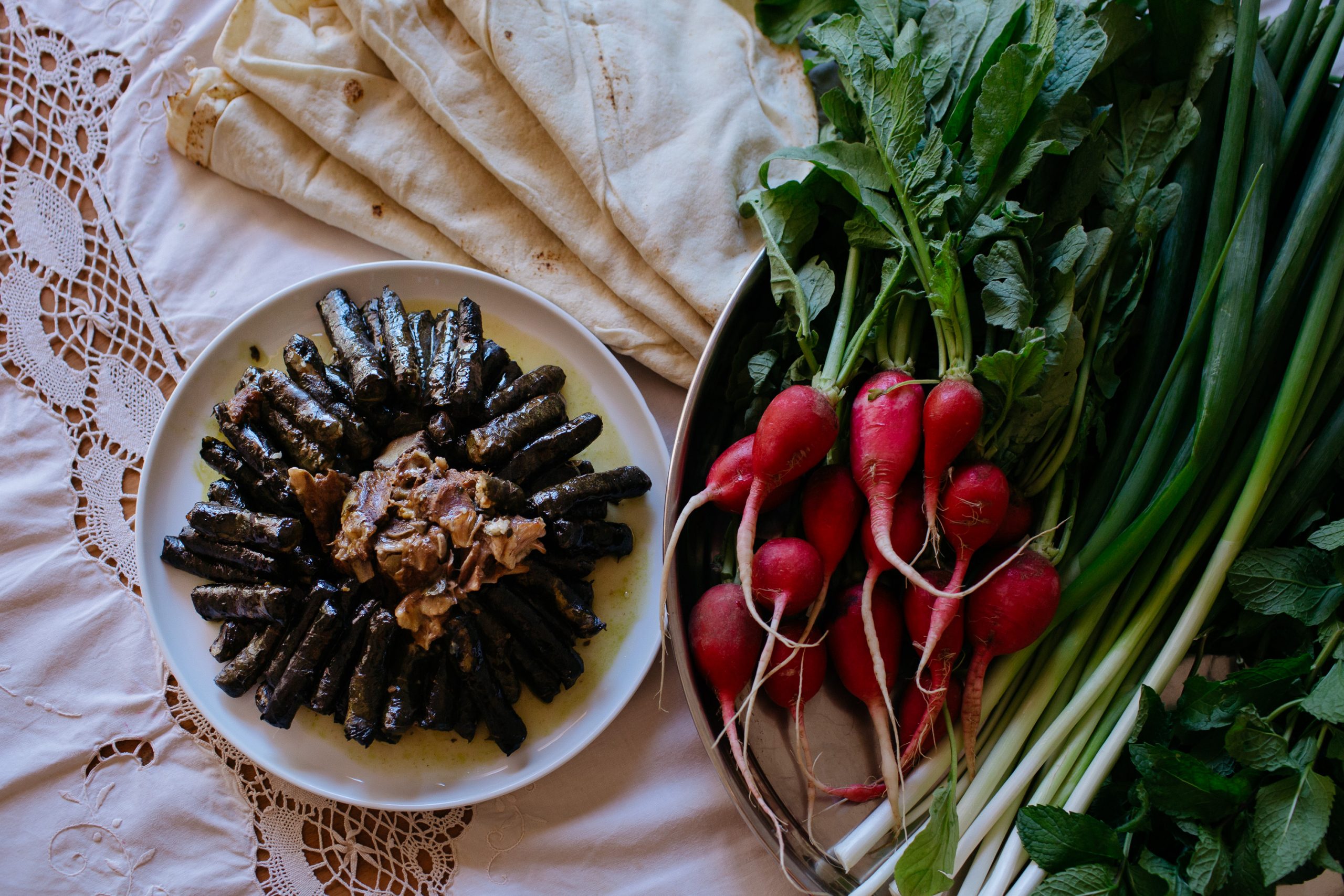
Preparing the leaves
Wash and soak the fresh leaves in water to remove any excess dirt. The leaves should be a fresh vibrant green colour.
Bring a pot of water to the boil and submerge a handful of leaves at a time to blanch until they turn a khaki green colour. Repeat with all the leaves. Put in a strainer over the sink and run cold water over them to cool down. Allow to cool and then place on a tray ready for rolling. It is important the leaves are cool so as to not spoil the stuffing mix.
Whilst the leaves are cooling, prepare your stuffing mix. Combine the rice, mince, salt and spices by kneading together with your hands to bring it all together.
On a clean, flat, wet surface such as a kitchen counter, lay a leaf flat with the rough side facing you and the smooth side of the leaf on the counter. The amount of filling will depend on the size of the leaf, but the aim is to have uniform rolled leaves to allow for even cooking. The average leaf should be the size of your palm so that ultimately you end up with a roll roughly ¾ – the full length of your pinkie and with the stuffing, the thickness of your pinkie, remembering the rice will expand when cooking.
If you have two quite small leaves you can place them alongside one another overlapping halfway to form a bigger leaf or if you have a giant leaf you can cut it in half down the centre.
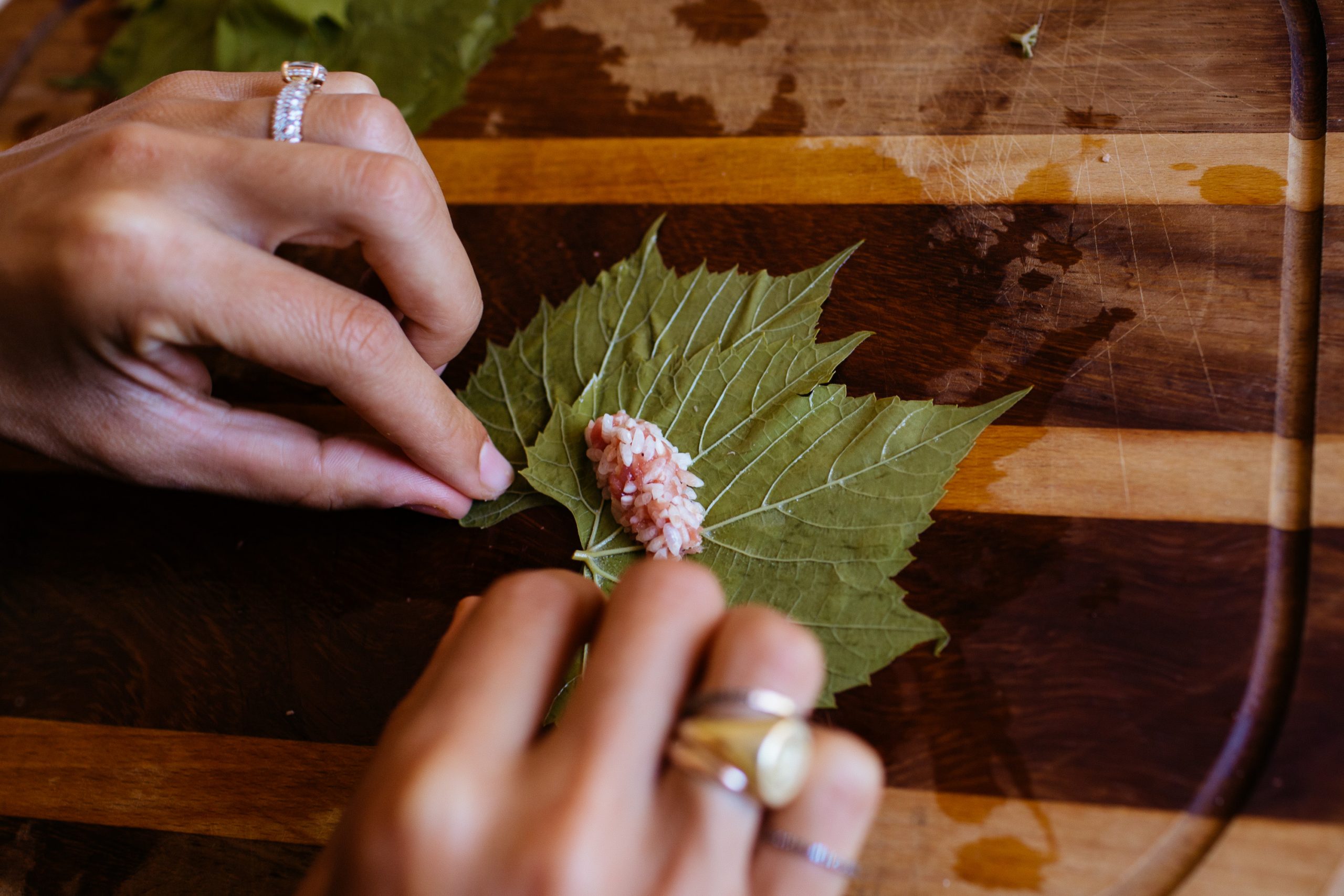
Place the filling in the centre of the leaf, about a centimetre from the base. Starting from the bottom, roll the leaf over the filling, tucking the edges to create a cylinder shape.
Tip: while rolling, press on the centre and pull it towards you to keep it tight. Each piece when rolled should be around 1cm in thickness. The key to rolling the leaves is to stay relaxed, not tense, so that you avoid ripping them.
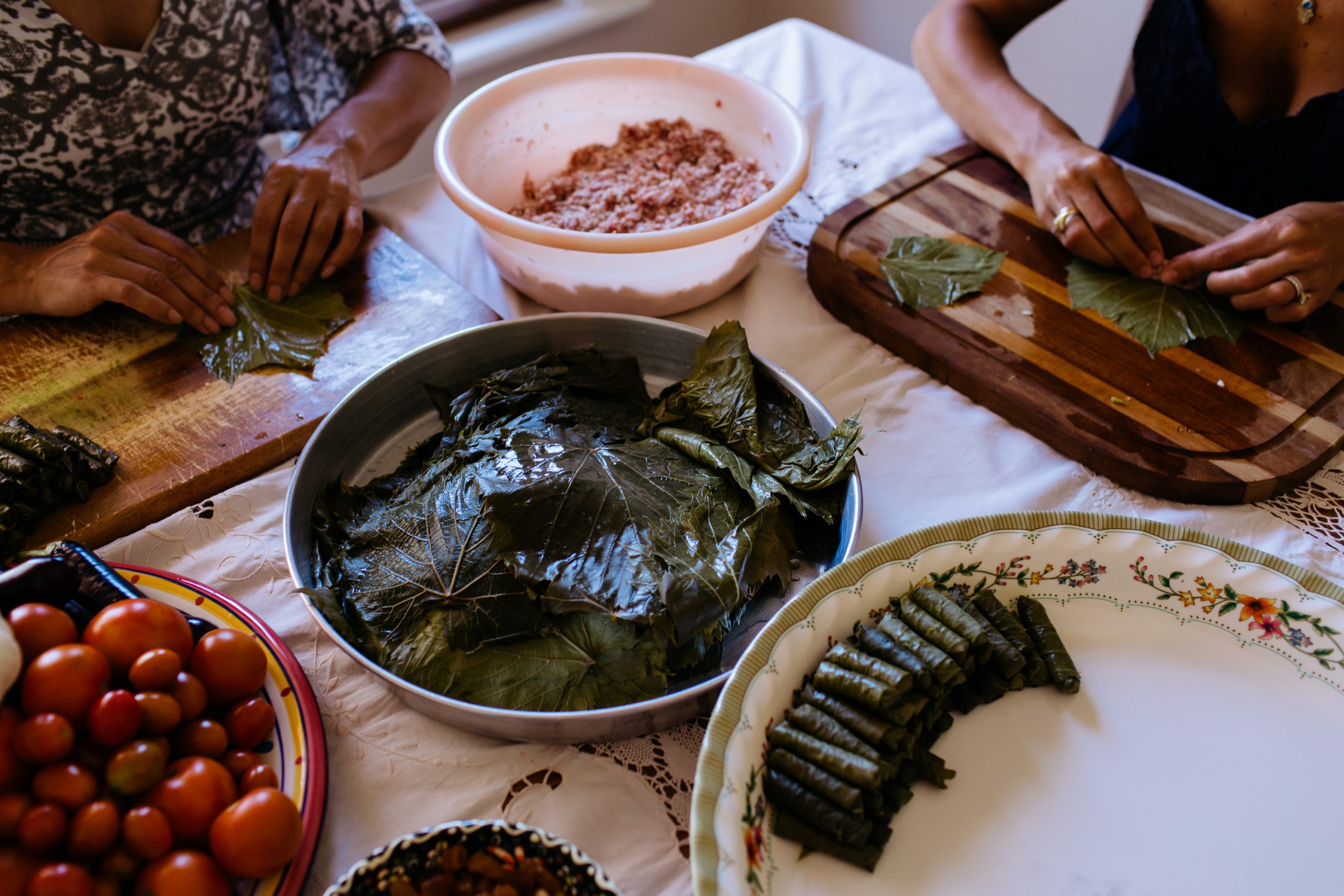
Preparing the meat and assembling
Place the meat and bones in a clean sink and rinse very well with cold water. Place meat and bones into a pot with water and bring to the boil. Remove the layer of scum that comes to the surface. Then drain the meat in the sink and wash off any excess that is on the meat with cold water.
In a 10 litre pot, melt a tablespoon of ghee and toss the meat and bones over a high heat to seal, adding salt and Baharat spice to the pot.
Turn the stove off and assemble the meat and bones as compactly as possible in the middle of the pot. Pack the vine leaf rolls in a circle around the pot one by one and in any gaps in between the meat and bones. Repeat until the last vine leaf roll is in the pot.
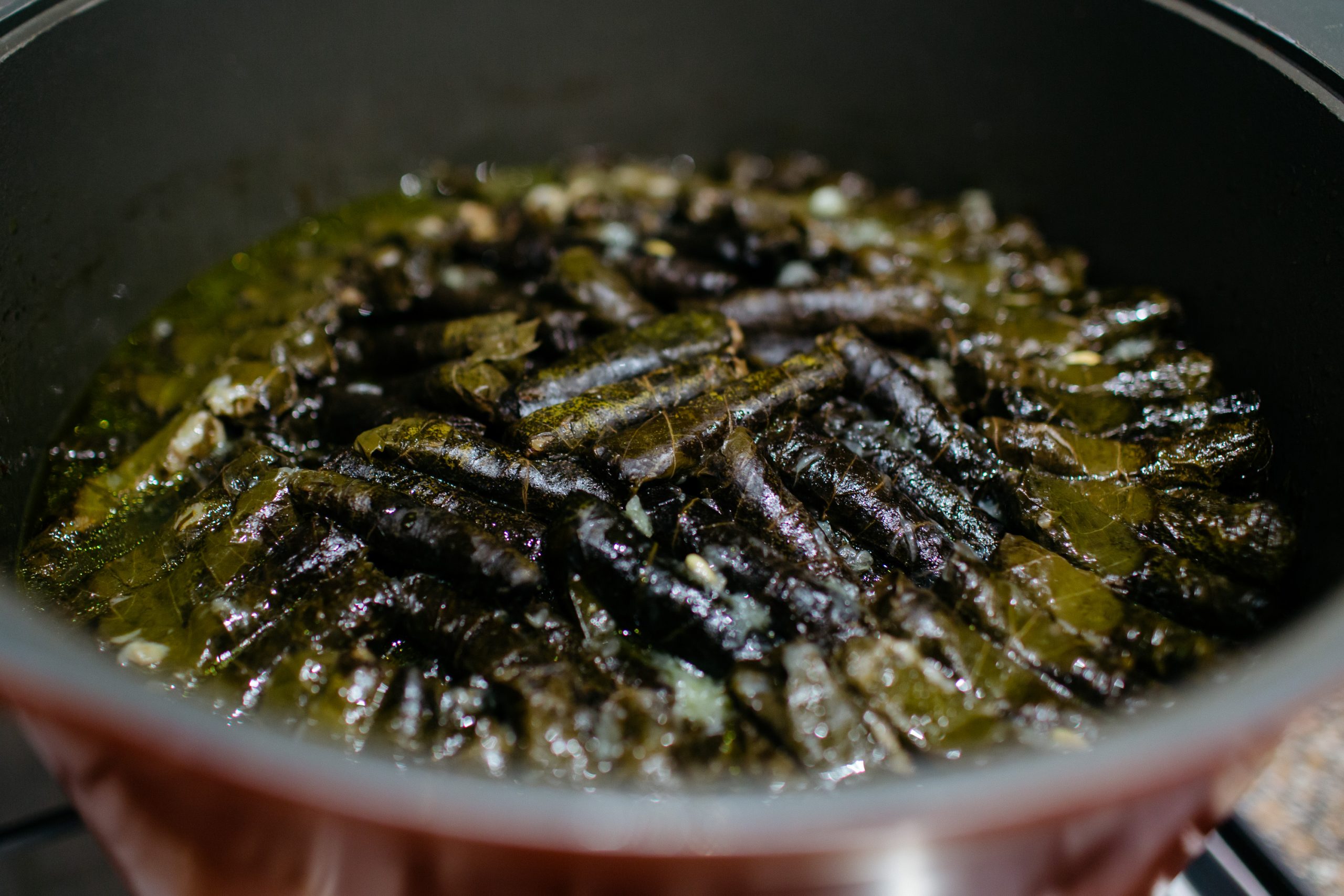
Place a heat proof plate (slightly smaller in diameter than the size of the pot) face down to press down on the vine leaves and put a big rock on top to weigh down the plate.
Now add 6 cups of water to the pot. Tilt your pot to the side, if the water gushes to the side you have plenty of water for your 20-hour cooking. 6 cups should be enough. If not add a 7th. Cover with the lid.
Cook on high for 30 mins and then turn down to low and leave on the stove-top to cook through overnight. After about 12 hours of cooking squeeze 3 lemons, maybe 4 depending on personal taste, and add to the pot, lifting the stuffed vine leaves away from the sides of the pot and swirling the lemon juice all around. Keep tasting the juice of the vine leaves and adjust with more lemon accordingly. By now the liquid in the pot should be a shiny, dark and a rich green colour. Cook on high for approximately 20 mins. Then reduce to medium heat and keep the pot covered for 20 mins. Uncover the pot and cook for a further 20 minutes. The top layer should sizzle and the lemon juice should have infused pan juices and vine leaves.
Serve by tipping the pot into an extra-large deep serving dish. The stuffed vine leaves should fall to the bottom and the meat should be falling off the bone at the top. This is a two- or three-person job!
Serve with fresh radish, spring onion, garlic cloves, mint and fresh Lebanese bread.
Best enjoyed eating with your hands.
Photographs courtesy of Lucy Leonardi of Who Does the Dishes
